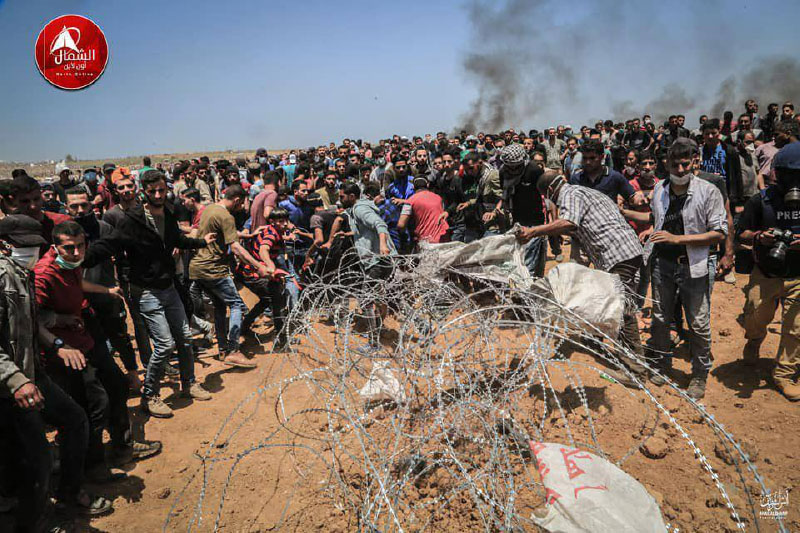- After preparations which lasted for about two months, mass riots began to take place every Friday near the border between the Gaza Strip and Israel. The declared purpose of these demonstrations and riots, organized and orchestrated by Hamas, was to break through the border fence and have masses of people enter into Israeli territory. According to the Palestinians, this should symbolically realize what the Palestinians refer to as the “right of return” of the Palestinian refugees (i.e., the destruction of the State of Israel). Another objective was to bring the severe economic situation of the Gaza Strip into public awareness and exert pressure to “break the siege.” The demonstrations and riots still haven’t ended. Hamas intends to pursue them also during the forthcoming weeks, even at the cost of more fatalities.
- Hamas aspired to mobilize hundreds of thousands of Gaza Strip residents to participate in these events. However, eventually, the number of participants did not exceed several tens of thousands. In the two peak events, on March 30, 2018 (Land Day, the opening events) and on May 14, 2018 (the day on which the US Embassy was relocated to Jerusalem), about 40,000 residents took part in the demonstrations and riots. On other Fridays, Hamas could not mobilize that many residents. During the rest of the week days, several thousands of people took part in the riots and there were also a number of attempts to carry out terrorist attacks.
- The riots culminated in the events of May 14, 2018, with attempts, halted by IDF soldiers, to penetrate en masse into Israeli territory. The attempts to break into Israeli territory were accompanied by intentionally increased violence, throwing pipe bombs and Molotov cocktails at IDF soldiers; attempting to cut the fence; and sending Molotov kites, which set fire to fields in Israeli communities adjacent to the Gaza Strip. As a result of the increase in the number of rioters and the extensive violence on their part (which was unusual compared to previous incidents), the number of fatalities reached its height. Those fatalities consist of Palestinians who were in the front line of the rioters, most of them Hamas operatives.
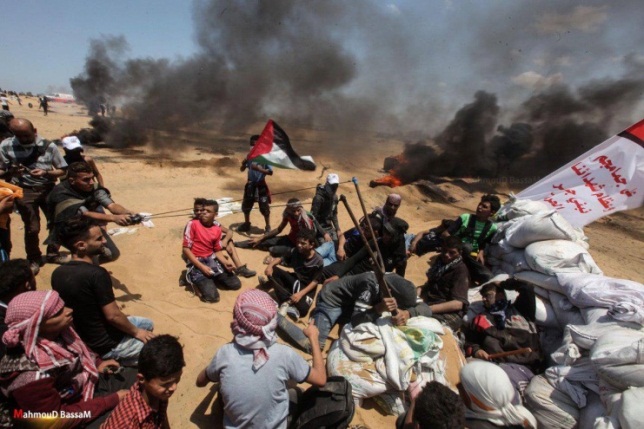
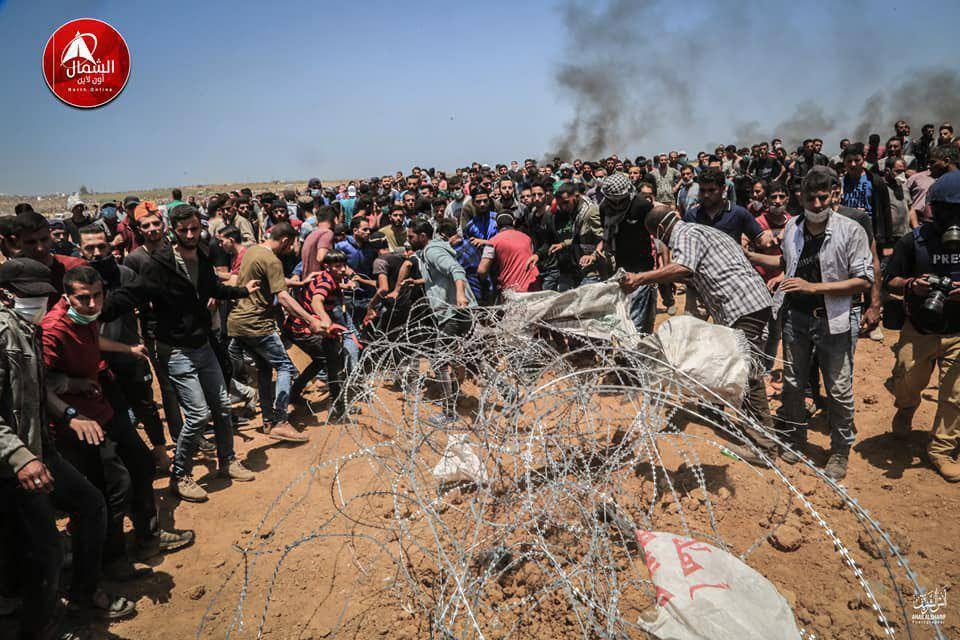
Right: Palestinian rioters cutting the barbed wire in clashes in east Jabalia (Facebook page of Beit Hanoun News, May 14, 2018). Left: Demonstrators in east Rafah hurling stones at IDF forces with a large slingshot (QUDSN Facebook page, May 14, 2018)
Findings of the examination of the names of fatalities
According to the findings of examinations carried out by the ITIC, at least 112 Palestinians were killed during the “Great Return March.”[1]In an examination of the names of the fatalities on an individual basis, 93 were identified as terrorist operatives or affiliated with the terrorist organizations, i.e., about 83% of those killed in the “return marches.” Most of the fatalities (63) are from Hamas (about 56% of the total killed in all the marches). Fatah, which had 21 fatalities, played a minor role, with no significant impact on the events. The other organizations, including PIJ operatives (four fatalities) refrained from playing a significant role, maybe because of their awareness that this is a Hamas “project.” The organizational affiliation of 19 of the fatalities is unknown to the ITIC. It may be assumed that these are Hamas operatives or civilians who do not belong to any organization.
- The findings of the ITIC, which indicate the central role of Hamas among the fatalities, are consistent with the figures provided by two senior Hamas figures in the Gaza Strip: Salah Bardawil said that 50 out of the 62 shaheeds who were killed in the events of May 14, 2018 (about 81%) belonged to Hamas. He added that in the events that took place between March 30, 2018 and May 14, 2018, 50% of the fatalities were Hamas operatives. Yahya Sinwar, head of the Hamas Political Bureau in the Gaza Strip, also said that on May 14, Hamas had over 60 shaheeds, and that “yet other 20 wounded are expected to die at any moment” (Al-Mayadeen Channel’s YouTube account, May 21, 2018).
- The findings of the examination of the identity of the fatalities carried out by the ITIC, and statements of senior Hamas officials, clearly demonstrate the central role played by Hamas in organizing the “return marches” and orchestrating them. The “return marches” were not “popular,” “peaceful” events, as falsely presented by Palestinian propaganda, but rather a Hamas strategic move accompanied by preplanned violence. This move was intended to free Hamas of its predicaments and achieve political and propaganda objectives (mainly, raising the “right of return” to the awareness of the Arab and international public and relieving the “siege” imposed on the Gaza Strip). Furthermore, the findings of the examination of the identity of the fatalities and reports from the ground clearly demonstrate that IDF soldiers did not shoot indiscriminately at innocent residents but instead hit terrorist operatives. These operatives were the dominant factor among those in the front line who tried to break into Israeli territory.
The identities of the fatalities of the “Great Return March” (March 30, 2018 – May 15, 2018)
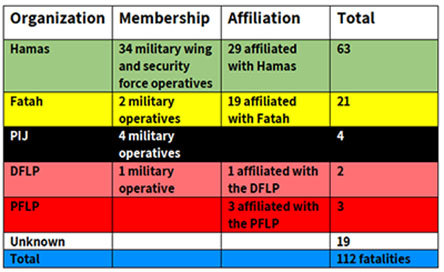
Note: About 83% of the fatalities of the “Great Return March” (92 people) were terrorist operatives or individuals affiliated with terrorist organizations. At least 67% of them were Hamas operatives. The number of Hamas operatives may increase because it is possible that the category “Without organizational affiliation” (19 fatalities) also includes unidentified Hamas operatives.
The identity of the fatalities of the “Great Return March” (March 30, 2018 – May 13, 2018)
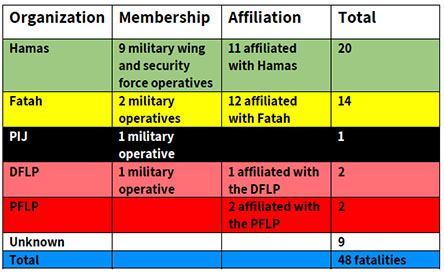
Note: About 81% of the fatalities of the “Great Return March” until May 14, 2018 (39 people) were terrorist operatives or individuals affiliated with terrorist organizations. Most of the fatalities were members of Hamas or affiliated with it.
The identity of the fatalities of the events of May 14 and 15, 2018
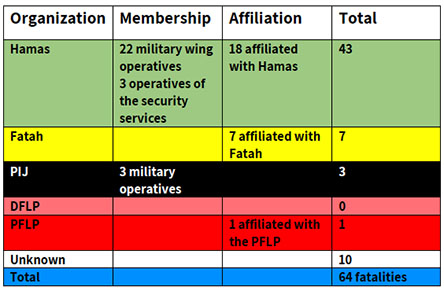
Note: About 84% of the fatalities on May 14 and 15, 2018 (54 people) were terrorist operatives or individuals affiliated with terrorist organizations. About 67% of them (43) were operatives of Hamas or affiliated with it. The organizational affiliation of 10 fatalities was not identified. It may be assumed that they include several Hamas operatives or individuals affiliated with Hamas.
Methodological notes
- Following are methodological notes on the findings of the identity of the march participants:
- These are interim findings pertaining to the period from March 30 to May 15, 2018. These findings are updated as at May 22, 2018. Names of other Palestinians who were seriously wounded and died of their injuries may be added to the number of fatalities.
- The ITIC’s list of names is based on the list of names (55 names) of the Palestinian Ministry of Health in the Gaza Strip. To supplement this list, in those cases where the reports of the Ministry of Health were incomplete (for example, non-publication of the names of fatalities or misspellings of the names that were published), the ITIC completed the data based on information obtained from social media and other open sources.
- The ITIC distinguishes between two basic categories of those belonging to terrorist organizations: the first is for those who were definitely operatives in the various organizations. The second is for those who were affiliated with the organizations. On the other hand, Salah Bardawil and Yahya Sinwar do not make such a distinction in their figures about Hamas casualties, and all of them are included under the heading “shaheeds of Hamas.”
- The examination is based on open source information of variable quality, mainly from social media (Facebook, YouTube, and Twitter). Palestinian websites were also used. In some cases the information is solid and in some cases it is circumstantial.
The events of May 14 and May 15, 2018
Main findings of the ITIC’s examination[2]
- On May 14, 2018, the day of the ceremony for the relocation of the US Embassy to Jerusalem, violent demonstrations were held in 13 locations along the Gaza-Israel border. Some 40,000 Palestinians participated in these demonstrations, and according to IDF sources, they were characterized by “unprecedented violence” in comparison with the previous marches.
- The May 14 rioters attempted to penetrate into Israeli territory, while burning tires and throwing pipe bombs and Molotov cocktails at the fence. During the riots, Molotov kites were sent to Israel, causing many fires in the fields of Israeli communities surrounding the Gaza Strip. Under the cover of the demonstrations, shooting attacks were carried out and IEDs were planted by armed terrorist squads. On the evening of May 14, the demonstrators left the area. In the ITIC’s assessment, they did so following instructions of the Hamas leadership, which supervised the events.
In the violent events on May 14, 2018, and in events that continued on a lower profile on May 15, 2018, the ITIC identified the names of 64 fatalities. Of these fatalities, 53 (around 84%) were terrorist operatives or affiliated with terrorist operatives, the vast majority (around 67%) from Hamas (Hamas cited a higher percentage: senior Hamas figures Yahya Sinwar and Salah Bardawil admitted that 50 out of 62 shaheeds, i.e., 81%, were Hamas operatives[3]). Most of those killed died during violent clashes with IDF forces, in the front line of demonstrators on the Israeli border. Some were killed while carrying out terrorist attacks or attempting to cross the security fence into Israeli territory. During the riots on May 14, 2018, the Palestinians also fired indiscriminately and massively at IDF drones (quadcopters) from the area of the tent camps in the rear (where there were apparently weapons). Therefore, it is possible that at least some of the Palestinian fatalities were hit by this gunfire.
Distribution of the fatalities from May 14 and May 15, 2018 by organization
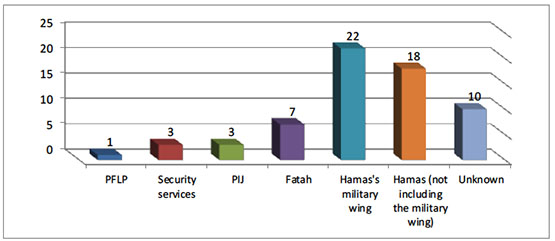
Methodological notes on how the names of the Palestinians killed in the events of May 14 and 15 were identified
- The number of fatalities: according to Dr. Ashraf al-Qudra, spokesman for the Ministry of Health in the Gaza Strip, 62 Palestinians were killed in the events of May 14 and 15, 60 of them on May 14 and 2 on May 15, 2018. This is also the number cited by senior Hamas figure Salah Bardawil when he announced that 50 of the 62 fatalities belonged to Hamas. However, on May 19, the number of fatalities rose to 65, following Dr. Ashraf al-Qudra’s announcement that three of the wounded had died of their injuries.
- Identifying the names of the fatalities: on May 14, 2018, the Palestinian Ministry of Health published a list of 55 names of fatalities (one of them was listed as a John Doe and the name of another fatality appeared twice on the list). This was the last detailed list of names found by the ITIC that was published by the Ministry of Health in the Gaza Strip. From then on, the names of those killed were reported sporadically on Dr. Ashraf al-Qudra’s Facebook page or in the Palestinian media.
The basis for the ITIC’s list of fatalities was the list of 55 fatalities published by the Palestinian Ministry of Health on May 14, 2018. The missing names were found by the ITIC through searches on Facebook pages and other media outlets, where the names of those killed or those who died from their injuries were reported sporadically. In these searches, the ITIC identified the names of 64 Palestinians who were killed on May 14 and May 15, 2018, and this was the basis for its examination.
Distribution of the fatalities on May 14 and May 15 by organizational affiliation
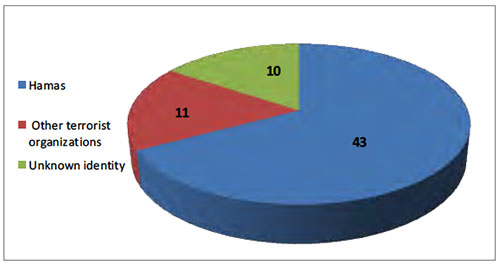
The central role played by Hamas’s casualties in the events of May 14, 2018
- Of the 64 casualties, the ITIC identified 43 names of Hamas operatives or individuals affiliated with Hamas (around 67%). Senior Hamas figure Salah Bardawil said that according to the official figures, 50 shaheeds out of the 62 fatalities belonged to Hamas. It is possible that seven additional fatalities who belonged to Hamas were included among the 10 fatalities whose affiliation is unknown. It is also possible that Bardawil (and Yahya Sinwar) exaggerated slightly in order to highlight the great sacrifice that Hamas has made and to repel internal criticism.
- Of the 43 Hamas fatalities identified by the ITIC, 22 were operatives of the military wing (the Izz al-Din al-Qassam Brigades) and three fatalities were both Hamas operatives and members of the internal security services[4]. The fatalities who were both Hamas operatives and members of the internal security services were given funerals by the Hamas military wing and were counted by the ITIC as operatives of the military wing. Eighteen fatalities were identified by the ITIC as affiliated with Hamas after their bodies were covered with a Hamas flag or other signs were found indicating their affiliation with Hamas.
The high percentage of Hamas operatives who were killed during the events of May 14 and in the previous events once again demonstrated Hamas’s central role in planning and controlling the events. In the “front line” of the violent demonstrations, there were also Hamas operatives in civilian clothes who played a central role in the acts of violence and attempts to break into the sovereign territory of the State of Israel. These operatives were “protected” by women and children who were sent by Hamas to the front line to serve as human shields. In the ITIC’s assessment, the large number of casualties among the operatives is primarily a result of Hamas’s central role in the events, and senior Hamas figures do not bother to hide this. Hence the Palestinian propaganda message that these were “popular” demonstrations carried out in “peaceful ways” is a false message that the Palestinians have managed to convey to many countries around the world, including Western countries.
Fatalities from other organizations and fatalities with no organizational affiliation
- Following are the identities of the fatalities from the other organizations:
- Fatah: Seven Fatah-affiliated fatalities. The fatalities included one female activist. She was the only woman killed in the events, despite the fact that the operatives of the various organizations encouraged women and children to come to the front line of the demonstrations, mainly to serve as human shields.
- The Palestinian Islamic Jihad (PIJ): three of the fatalities were PIJ operatives. All of them were operatives of the military wing.
- The Popular Front for the Liberation of Palestine (PFLP): one fatality who was affiliated with the PFLP.
- With no organizational affiliation: no reports of the organizational affiliation of 10 operatives who were killed were found.
- The ITIC still hasn’t identified 10 people killed in the events of May 14 and May 15, 2018. It can be assumed that some of them were civilians, but some of them may have been Hamas operatives who were not identified by the ITIC.
Continuation to be expected
In the ITIC’s assessment, from Hamas’s perspective, the violent riots and demonstrations have not yet exhausted their inherent political and propaganda benefits. Senior Hamas figures call on their operatives and the entire Gazan public to continue the riots and even to die as shaheeds. The “National Authority for the Great Return March,” serving as a front for Hamas, called on the Gazan public to continue the marches on Friday, May 25, under the slogan “Continuing despite the siege.”
- Yahya Sinwar, head of the Hamas Political Bureau in the Gaza Strip, said that “special events” would take place on Naksa Day (June 5, the day of the defeat of the Arab states in the Six Day War) and on Jerusalem Day (June 8, support events for Palestinians initiated by Iran). Therefore, it can be assumed that in the weeks ahead, Hamas will continue to sacrifice the lives of its operatives, civilians and other terrorist operatives, while encouraging and fueling the political and propaganda campaign being waged against Israel.
Appendix
- Attached is an appendix containing detailed information about the 64 fatalities in the events of May 14 and 15, including their organizational affiliation, based on examinations carried out by the ITIC. A detailed analysis of the identity of those killed up to May 14 was published, as aforesaid, in the ITIC’s documents on the subject of the “Great Return Marches.”





